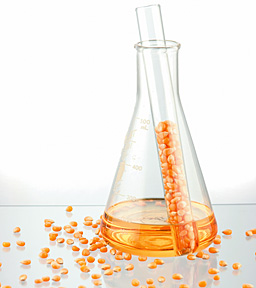Too Much of a Sweet Thing
While there may not be a definitive, proven connection (yet) between either high-fructose corn syrup or table sugar and the growing rate of obesity, the fact is that since 1977, more food items consumed contain sugar.
Whether it is fructose, glucose, sucrose or high-fructose corn syrup, the average person consumes sugar at least once a day and likely many times a day. This was not the case 50 years ago. As the use of sweeteners in manufactured foods has increased, so has the prevalence of obesity.
Some items that not surprisingly include high-fructose corn syrup include most sugary cereals, toaster pastries, soft drinks, juice pouches and boxes, jams and jellies, salad dressings, sauces, ketchup, canned fruit, cookies and crackers. Some unexpected products that may contain HFCS include many canned ravioli and pasta meals, canned soups, peanut butter, bread, breakfast/snack bars, vegetable drinks, coffee and energy drinks.
The Bottom Line
Be diligent in reading food labels more carefully. Even more than that, perhaps it's time to stop buying products with labels. If a product is packaged or has a label, it has often been altered from its original form in some way. We need to return to the basics, such as fresh vegetables, lean meats, fruits and grains. We need to eat - and feed our children - food in its most natural form - not packaged, not altered and not sweetened. Your doctor can provide you with more information about high-fructose corn syrup and help you and your family develop a healthy, natural dietary plan that avoids HFCS and other artificial, processed ingredients and foods.
Where's HFCS? It's Everywhere
Not surprisingly, foods that contain high-fructose corn syrup include most sugary cereals, toaster pastries, soft drinks, juice pouches and boxes, jams and jellies, salad dressings, sauces, ketchup, canned fruit, cookies and crackers. However, did you know that many canned ravioli and pasta meals, canned soups, peanut butter, bread, breakfast/snack bars, vegetable drinks, coffee and energy drinks may also contain HFCS? In fact, check your pantry and you'll likely discover that most of your foods contain high-fructose corn syrup; even the ones with no business having any added sugar.
The History of HFCS
 Until 1957, high-fructose corn syrup (HFCS) didn't exist. That year, two researchers named Marshall and Kooi developed an enzyme called glucose isomerase that could work on corn syrup to rearrange the molecular composition of glucose and convert it to fructose. Glucose isomerase causes the isomerization, or rearrangement, of glucose. When natural glucose in corn syrup is converted to fructose, the syrup becomes sweeter. "High fructose" simply means that the percentage of fructose is higher.
Until 1957, high-fructose corn syrup (HFCS) didn't exist. That year, two researchers named Marshall and Kooi developed an enzyme called glucose isomerase that could work on corn syrup to rearrange the molecular composition of glucose and convert it to fructose. Glucose isomerase causes the isomerization, or rearrangement, of glucose. When natural glucose in corn syrup is converted to fructose, the syrup becomes sweeter. "High fructose" simply means that the percentage of fructose is higher.
The significance of being able to genetically alter corn syrup from a mildly sweet syrup to a profoundly sweet syrup was not lost on the corn growers, and it couldn't have come at a better time. In 1977, new tariffs and sugar quotas made the cost of importing sugar more burdensome. With the increase of sugar costs, production costs on new dietary staples rose significantly.
The producers of these items needed a more costeffective alternative sweetener. In 1984, when soft-drink manufacturers like Coca-Cola and Pepsi began using high-fructose corn syrup, HFCS really jumped in terms of general acceptance. Production grew from about 3 million tons in 1980 to about 8 million tons in 1995.
Claudia Anrig, DC, practices in Fresno, Calif., and is on the board of directors of the International Chiropractic Pediatric Association, an organization that can answer your questions regarding the value of chiropractic care during and after pregnancy.

